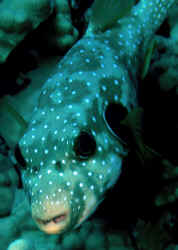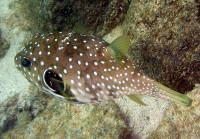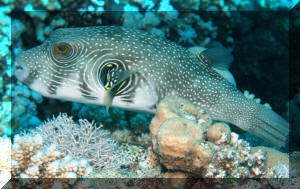|
Related Articles:
Puffers in General,
Puffer Care and Information, A
Saltwater Puffer Primer: Big Pufferfish! by Mike Maddox, Fresh to
Brackish Water Puffers, Burrfishes/Porcupinefishes, Tobies/Sharpnose Puffers, Boxfishes, Pufferfish Dentistry By Kelly Jedlicki and Anthony Calfo, Puffer Care and Information
by John (Magnus) Champlin, Things That My Puffers
Have Told Me by Justin Petrey,
Related FAQs: True
Puffers 1, True Puffers 2,
True Puffers 3, Tetraodont Identification, Tetraodont Behavior, Tetraodont Compatibility, Tetraodont Selection, Tetraodont Systems, Tetraodont Feeding, Tetraodont Disease, True Puffer Disease 2, Tetraodont Reproduction, Puffer Identification, Puffer Behavior, Puffer Compatibility, Puffer Selection, Puffer Systems, Puffer Feeding, Puffer Disease, Puffer Dentistry, Puffer
Reproduction, True
Puffers, True Puffers
2, True
Puffers 3, Freshwater Puffers 1, FW Puffers 2, FW Puffers 3, FW Puffer Identification,
FW Puffer Behavior,
FW Puffer
Selection, FW
Puffer Compatibility, FW Puffer Systems, FW Puffer Feeding, FW Puffer Disease, FW Puffer Reproduction,
BR Puffer
Identification, BR Puffer
Selection, BR Puffer
Compatibility, BR Puffer Systems,
BR Puffer
Feeding, BR
Puffer Disease, BR Puffer Disease 2,
BR Puffer
Reproduction, Green
Spotted Puffers, Burrfishes/Porcupinefishes, Tobies/Sharpnose Puffers, Boxfishes
/The Conscientious Marine
Aquarist
"True"
Puffers, Family Tetraodontidae, (except
the Tobies/Sharpnose
Puffers, Subfamily Canthigastrinae), Part
1
Part II,
Part II, Part III,
Part IV, Part V,
Part VI
|

|
|
Bob Fenner
|
Arothron hispidus Hawai'i
|
This is the most notable group of puffers known for their ability to
"puff up" when alarmed or challenged. This is actually done
by rapidly ingesting large quantities of water into a distensible part
of their stomachs (the ventral diverticulum). Both the true puffers and
Sharpnose Tobies also have characteristic teeth plates that look more
like beaks. Other characteristics include the more posterior position
of their unpaired fins (like other tetraodontiform fishes; triggers,
Boxfishes... used for slow, exacting locomotion) which are w/o hard
rays, a lack of ribs and scales (hard to blow up with them), and
slit-like gill openings.
Tetraodontidae is the
"true" puffer family to many; it contains all the non-spiny,
non-armored, non-deep-bodied puffers. These animals can really inflate
their bodies, to a few times "regular" diameter; their bodies
are either naked or dotted with short prickles. The viscera,
particularly the gonads of puffers is toxic, the tetrodotoxin poison at
times fatal to sushi bar goers and hapless predators. Twelve freshwater
species (in the genera Carinotetraodon, Chonerhinos, and
Tetraodon); nineteen genera and 121 species overall, two
subfamilies: is the "true" puffer family to many; it contains
all the non-spiny, non-armored, non-deep-bodied puffers. These animals
can really inflate their bodies, to a few times "regular"
diameter; their bodies are either naked or dotted with short prickles.
The viscera, particularly the gonads of puffers is toxic, the
tetrodotoxin poison at times fatal to sushi bar goers and hapless
predators. Twelve freshwater species (in the genera Carinotetraodon,
Chonerhinos, and Tetraodon); nineteen genera and 121 species
overall, two subfamilies:
Again, on the negative side for aquarists is
these fishes possession of tetrodotoxin, powerful poison to ward off
would-be predators. A problem at times for ones that die, dissolve w/o
notice in aquariums, and at times simply release same into their
waters. Do not disturb.
The Tetraodontinae appear broadly rounded in cross
section. Of the eighteen genera, only Arothron is regularly sold
in the west. This genus has nothing but exemplary, personality species.
Most often available are the guinea fowl (A. meleagris), bulldog
or black-spotted puffers (A. nigropunctatus), in black, gray,
golden forms, or a splotchy mix thereof. The Indo-Pacific stars and
stripes puffer, A. hispidus is found now and then and is also
excellent.
Here we'll highlight the most
commonly available species of "true" Puffers used in
the aquarium interest.
| Amblyrhynchotes honkenii (Bloch 1785), the
Evileye Blassop. Indo-west Pacific, from South Africa to China. To
twelve inches in length. |
No pic
|
| Amblyrhynchotes rufopunctatus Li 1962.
Western central Pacific and South China Sea. |
No pic
|
| Arothron caeruleopunctatus (Matsuura 1994).
Indo-west Pacific. To thirty two inches in length in the wild. Here
is a two footer in Fiji. |
MD.JPG) |
| Arothron carduus (Cantor 1849). Eastern
Indian Ocean. |
No pic
|
Bigger PIX:
The images in this table are linked to large
(desktop size) copies. Click on "framed" images to go to
the larger size. |
MD.JPG)
%20MD.JPG) |
| Arothron firmamentum (Temminck &
Schlegel 1850), the Starry Toado. Indo-west Pacific around edge of
South Africa into the Atlantic. To fourteen inches in length. |
No pic
|
| Arothron gillbanksii (Clarke 1897).
South-western Pacific. |
No pic
|
| Arothron hispidus (Linnaeus 1758), the
White-Spotted Puffer. Indo-Pacific, Red Sea, east African coast,
tropical east Pacific coast. To twenty inches in length in the
wild. Cute when small, and very hardy... just big eaters and mess
makers. At right, one in the Galapagos, below are pictured a four
inch juvenile in captivity, one in Hawai'i, a one foot specimen
in the Red Sea, and a fifteen inch mottled or "koi" one
in the Seychelles. |

|
Bigger PIX:
The images in this table are linked to large (desktop size) copies.
Click on "framed" images to go to the larger size. |
MD.JPG) 
.JPG)
.JPG)
%20MD.JPG) |
Part II,
Part II, Part III,
Part IV, Part V,
Part VI
|
|

